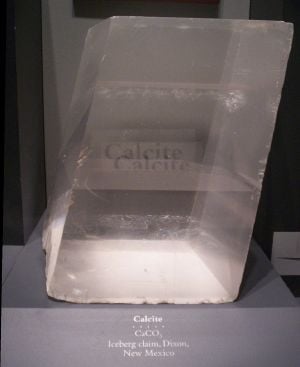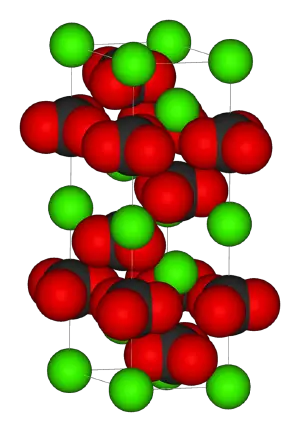Difference between revisions of "Calcite" - New World Encyclopedia
| Line 4: | Line 4: | ||
'''Calcite''' is a [[carbonate]] [[mineral]] and is among the most widely distributed minerals on the [[Earth]]'s surface. Chemically, it is known as [[calcium carbonate]] and has the formula CaCO<sub>3</sub>. | '''Calcite''' is a [[carbonate]] [[mineral]] and is among the most widely distributed minerals on the [[Earth]]'s surface. Chemically, it is known as [[calcium carbonate]] and has the formula CaCO<sub>3</sub>. | ||
| + | |||
| + | It occurs in many varieties. | ||
| + | |||
| + | It is perhaps best known for its optical property called [[birefringence]] or [[double refraction]], because of which objects viewed through a clear piece of calcite appear doubled. | ||
| + | |||
== Occurrence == | == Occurrence == | ||
| − | + | Calcite is a common constituent of [[sedimentary rock]]s, particularly [[limestone]], and is the primary mineral in [[Metamorphic rock|metamorphic]] [[marble]]. It also occurs as a [[vein]] mineral in deposits from [[hot spring]]s, and it forms [[stalactite]]s and stalagmites in [[cavern]]s. | |
| + | |||
| + | This mineral is often the primary constituent of the shells of marine organisms. It is found, for instance, in [[plankton]] (such as [[coccolith]]s and planktic [[foraminifera]]), the hard parts of red [[algae]], some [[sea sponge|sponge]]s, [[brachiopod]]s, [[echinoderm]]s, most [[bryozoa]], and parts of the shells of some [[Bivalvia|bivalves]], such as [[oyster]]s and rudists). | ||
== Characteristics == | == Characteristics == | ||
| − | Calcite [[ | + | Calcite is usually white or colorless, but shades of gray, red, yellow, green, blue, violet, brown, or even black can occur when the mineral is charged with impurities. It is transparent to opaque and occasionally shows [[fluorescence]] or [[phosphorescence]]. It has a vitreous (glassy) luster in crystallized varieties. It has a [[Mohs hardness]] of 3 and a [[specific gravity]] of 2.71. |
| + | |||
| + | [[Crystal]]s of calcite are [[Hexagonal (crystal system)|hexagonal]]-rhombohedral, though actual calcite rhombohedrons are rare in nature. However, they show a remarkable variety of habits, including acute to obtuse rhombohedrons, tabular forms, prisms, or various scalenohedrons. Moreover, calcite exhibits several [[Crystal twinning|twinning]] types, adding to the variety of observed forms. It may occur as fibrous, granular, lamellar, or compact forms. Cleavage is usually in three directions parallel to the rhombohedron form. Its fracture is conchoidal, but difficult to obtain. | ||
| + | |||
| + | A beautifully transparent variety used for optical purposes comes from [[Iceland]] and is called ''Iceland spar''. Acute scalenohedral crystals are sometimes referred to as ''dogtooth spar''. | ||
| + | |||
| + | Single crystals of calcite display an optical property called [[birefringence]] or [[double refraction]]. This property involves the splitting of a ray of light into two rays when it passes through the crystal. Thus, objects viewed through a clear piece of calcite appear doubled in all their parts—a phenomenon first described by the [[Denmark|Danish]] scientist [[Rasmus Bartholin]] in 1669. | ||
| − | |||
| − | |||
| − | + | * Calcite represents the stable form of calcium carbonate; [[aragonite]] will change to calcite at 470°C. | |
== Gallery == | == Gallery == | ||
Revision as of 23:11, 20 April 2007

Calcite is a carbonate mineral and is among the most widely distributed minerals on the Earth's surface. Chemically, it is known as calcium carbonate and has the formula CaCO3.
It occurs in many varieties.
It is perhaps best known for its optical property called birefringence or double refraction, because of which objects viewed through a clear piece of calcite appear doubled.
Occurrence
Calcite is a common constituent of sedimentary rocks, particularly limestone, and is the primary mineral in metamorphic marble. It also occurs as a vein mineral in deposits from hot springs, and it forms stalactites and stalagmites in caverns.
This mineral is often the primary constituent of the shells of marine organisms. It is found, for instance, in plankton (such as coccoliths and planktic foraminifera), the hard parts of red algae, some sponges, brachiopods, echinoderms, most bryozoa, and parts of the shells of some bivalves, such as oysters and rudists).
Characteristics
Calcite is usually white or colorless, but shades of gray, red, yellow, green, blue, violet, brown, or even black can occur when the mineral is charged with impurities. It is transparent to opaque and occasionally shows fluorescence or phosphorescence. It has a vitreous (glassy) luster in crystallized varieties. It has a Mohs hardness of 3 and a specific gravity of 2.71.
Crystals of calcite are hexagonal-rhombohedral, though actual calcite rhombohedrons are rare in nature. However, they show a remarkable variety of habits, including acute to obtuse rhombohedrons, tabular forms, prisms, or various scalenohedrons. Moreover, calcite exhibits several twinning types, adding to the variety of observed forms. It may occur as fibrous, granular, lamellar, or compact forms. Cleavage is usually in three directions parallel to the rhombohedron form. Its fracture is conchoidal, but difficult to obtain.
A beautifully transparent variety used for optical purposes comes from Iceland and is called Iceland spar. Acute scalenohedral crystals are sometimes referred to as dogtooth spar.
Single crystals of calcite display an optical property called birefringence or double refraction. This property involves the splitting of a ray of light into two rays when it passes through the crystal. Thus, objects viewed through a clear piece of calcite appear doubled in all their parts—a phenomenon first described by the Danish scientist Rasmus Bartholin in 1669.
- Calcite represents the stable form of calcium carbonate; aragonite will change to calcite at 470°C.
Gallery
- Calcite Morocco.jpg
Calcite from Middle Atlas, Morocco
- Calcite09.jpg
Calcite from Montana, USA
See also
- Birefringence
- Calcium
- Carbonate
- Limestone
- Marble
- Mineral
ReferencesISBN links support NWE through referral fees
- Farndon, John. 2006. The Practical Encyclopedia of Rocks & Minerals: How to Find, Identify, Collect and Maintain the World's best Specimens, with over 1000 Photographs and Artworks. London: Lorenz Books. ISBN 0754815412.
- Klein, Cornelis, and Barbara Dutrow. 2007. Manual of Mineral Science. 23rd ed. New York: John Wiley. ISBN 978-0471721574.
- Pellant, Chris. 2002. Rocks and Minerals. Smithsonian Handbooks. New York: Dorling Kindersley. ISBN 0789491060.
- Shaffer, Paul R., Herbert S. Zim, and Raymond Perlman. 2001. Rocks, Gems and Minerals. Rev. ed. New York: St. Martin's Press. ISBN 1582381321.
- Mindat.org. 2007. Calcite. Mindat.org. Retrieved April 10, 2007.
- Mineral Gallery. 2006. The Mineral Calcite. Amethyst Galleries. Retrieved April 10, 2007.
External links
- Calcite. Retrieved April 10, 2007.
- Calcite Mineral Data. Retrieved April 10, 2007.
- Calcite. (Giant crystals of calcite in Iceland.) Retrieved April 10, 2007.
Credits
New World Encyclopedia writers and editors rewrote and completed the Wikipedia article in accordance with New World Encyclopedia standards. This article abides by terms of the Creative Commons CC-by-sa 3.0 License (CC-by-sa), which may be used and disseminated with proper attribution. Credit is due under the terms of this license that can reference both the New World Encyclopedia contributors and the selfless volunteer contributors of the Wikimedia Foundation. To cite this article click here for a list of acceptable citing formats.The history of earlier contributions by wikipedians is accessible to researchers here:
The history of this article since it was imported to New World Encyclopedia:
Note: Some restrictions may apply to use of individual images which are separately licensed.


